heating HONDA PASSPORT 2000 2.G Owners Manual
[x] Cancel search | Manufacturer: HONDA, Model Year: 2000, Model line: PASSPORT, Model: HONDA PASSPORT 2000 2.GPages: 267, PDF Size: 3.03 MB
Page 47 of 267

Carbo
n Monoxid e Hazar d
Your vehicle's exhaust contains
carbon monoxide gas. You should
have no problem with carbon monoxide entering the vehicle in
normal driving if you maintain your vehicle properly. Have theexhaust system inspected for leaks
whenever:
The vehicle is raised for an oil
change.
You notice a change in the
sound of the exhaust.
The vehicle was in an accident that may have damaged the
underside. High levels of carbon monoxide
can collect rapidly in enclosed areas, such as a garage. Do not
run the engine with the garage door closed. Even with the door
open, run the engine only longenough to move the vehicle out of
the garage.
With the tailgate glass open, air
flow can pull exhaust gas into theinterior. This can create a
hazardous condition. If you must drive with the tailgate glass open,
open all the windows and set the
heating and cooling system asshown below.
If you must sit in your parked
vehicle, even in an unconfined
area, with the engine running, adjust the heating and cooling
system as follows: 1. Slide the lever to
2. Turn the dial to mode.
3. Turn the fan on high speed.
4. Set the temperature control to a comfortable setting.
Driver an d Passenge r Safet y
Carbon monoxid
e gas is toxic.
Breathing it can cause
unconsciousness and even kill
you.
Avoid any enclosed areas or
activities that expose you to
carbon monoxide.
Page 64 of 267
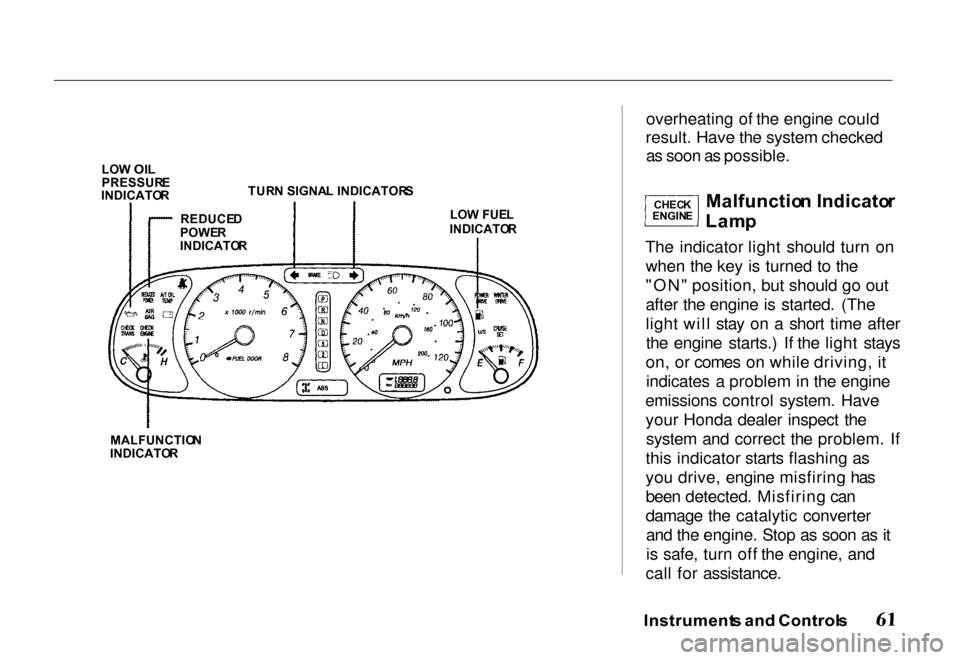
LO
W
OI L
PRESSUR E
INDICATO R TUR
N SIGNA L INDICATOR S
MALFUNCTIO N
INDICATO R
overheating of the engine could
result. Have the system checked as soon as possible.
Malfunctio n Indicato r
Lam p
The indicator light should turn on when the key is turned to the
"ON" position, but should go out
after the engine is started. (The
light will stay on a short time afterthe engine starts.) If the light stays
on, or comes on while driving, it indicates a problem in the engine
emissions control system. Have your Honda dealer inspect thesystem and correct the problem. If
this indicator starts flashing as
you drive, engine misfiring has
been detected. Misfiring can
damage the catalytic converter and the engine. Stop as soon as it
is safe, turn off the engine, and
call for assistance.
Instrument s an d Control s
LO
W FUE L
INDICATO R
REDUCE
D
POWE R
INDICATO R CHEC
K
ENGIN E
Page 115 of 267
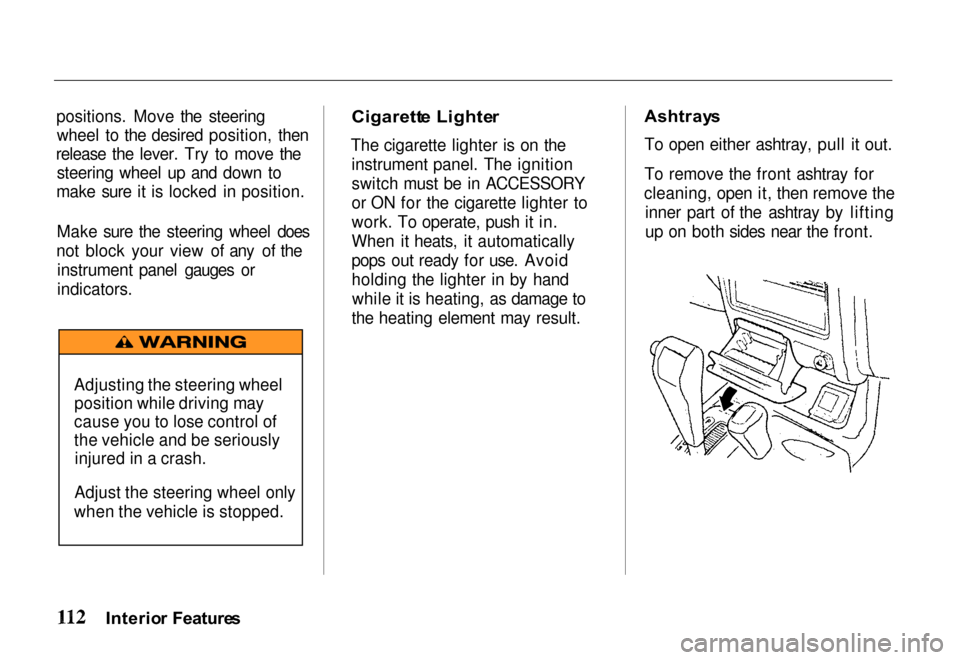
positions. Move the steering
wheel to the desired position, then
release the lever. Try to move the steering wheel up and down to
make sure it is locked in position.
Make sure the steering wheel does
not block your view of any of the instrument panel gauges or
indicators.
Cigarett
e Lighte r
The cigarette lighter is on the instrument panel. The ignition
switch must be in ACCESSORY
or ON for the cigarette lighter to
work. To operate, push it in.
When it heats, it automatically
pops out ready for use. Avoid
holding the lighter in by handwhile it is heating, as damage to
the heating element may result.
Ashtray
s
To open either ashtray, pull it out.
To remove the front ashtray for
cleaning, open it, then remove the inner part of the ashtray by lifting
up on both sides near the front.
Interio r Feature s
Adjusting the steering wheel
position while driving may
cause you to lose control of
the vehicle and be seriously injured in a crash.
Adjust the steering wheel only
when the vehicle is stopped.
Page 118 of 267

Comfor
t an d Convenienc e Feature s
The heating and air conditioning system in your vehicle provides a
comfortable driving environmentin all weather conditions.
The audio system has many
features. This section describes
those features and how to use
them.
Heating and Cooling ...... 116
Ventilation .............. 118
Audio System ............ 121 AM/FM/Cassette StereoAudio System (LX, EX) 121 Operating the Radio .. 121
Adjusting the Sound .. 123
Operating the
Cassette Player ..... 124
Caring for the
Cassette Player ..... 126
Operating the Optional CD Changer ........ 127
AM/FM/Cassette/ CD Changer StereoAudio System (EX-L) . 129 Operating the Radio . . 129
Adjusting the Sound . . 131
Radio Frequencies ... 132Operating the Cassette Player ..... 134
Caring for the Cassette Player ..... 137 Operating the
CD Changer ........ 138
Protecting
Compact Discs ...... 142
Cruise Control ........... 143
Keyless Entry ........... 147
Anti-Theft System ........ 148
Digital Clock ............ 149
Comfor t an d Convenienc e Feature s
Page 119 of 267
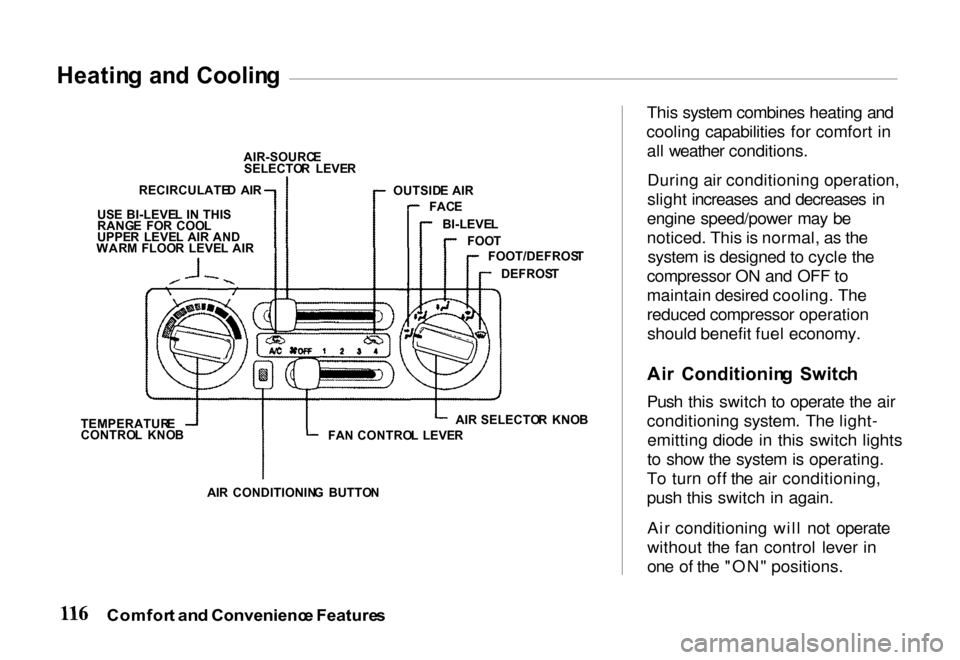
Heatin
g an d Coolin g
This system combines heating and
cooling capabilities for comfort in all weather conditions.
During air conditioning operation,
slight increases and decreases in
engine speed/power may be
noticed. This is normal, as the system is designed to cycle the
compressor ON and OFF to
maintain desired cooling. The
reduced compressor operation should benefit fuel economy.
Ai r Conditionin g Switc h
Push this switch to operate the air
conditioning system. The light- emitting diode in this switch lights
to show the system is operating.
To turn off the air conditioning,
push this switch in again.
Air conditioning will not operate
without the fan control lever in
one of the "ON" positions.
Comfor t an d Convenienc e Feature s
AIR-SOURC
E
SELECTO R LEVE R
OUTSID E AIR
FAC E
BI-LEVE L
FOO T
FOOT/DEFROS T
DEFROS T
FA N CONTRO L LEVE RAIR
SELECTO R KNO B
AI R CONDITIONIN G BUTTO N
TEMPERATUR
E
CONTRO L KNO B
US
E BI-LEVE L I N THI S
RANG E FO R COO L
UPPE R LEVE L AIR AND
WAR M FLOO R LEVE L AI R
RECIRCULATE
D AI R
Page 121 of 267
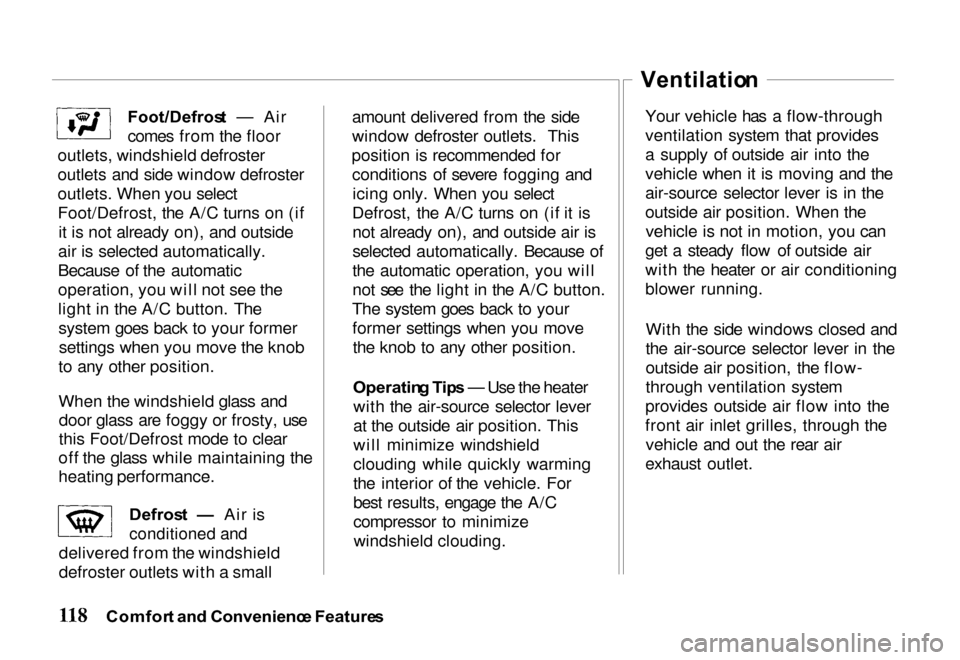
Foot/Defros
t — Air
comes from the floor
outlets, windshield defroster
outlets and side window defroster
outlets. When you select
Foot/Defrost, the A/C turns on (if it is not already on), and outside
air is selected automatically.
Because of the automatic
operation, you will not see the
light in the A/C button. The system goes back to your formersettings when you move the knob
to any other position.
When the windshield glass and door glass are foggy or frosty, use
this Foot/Defrost mode to clear
off the glass while maintaining the
heating performance.
Defrost — Air is
conditioned and
delivered from the windshield
defroster outlets with a small amount delivered from the side
window defroster outlets. This
position is recommended for conditions of severe fogging andicing only. When you select
Defrost, the A/C turns on (if it is not already on), and outside air is
selected automatically. Because of
the automatic operation, you will
not see the light in the A/C button.
The system goes back to your former settings when you movethe knob to any other position.
Operatin g Tip s — Use the heater
with the air-source selector lever
at the outside air position. This
will minimize windshield
clouding while quickly warming
the interior of the vehicle. For
best results, engage the A/C
compressor to minimize windshield clouding.
Ventilatio
n
Your vehicle has a flow-through
ventilation system that provides
a supply of outside air into the
vehicle when it is moving and the
air-source selector lever is in the
outside air position. When the vehicle is not in motion, you can
get a steady flow of outside air
with the heater or air conditioning
blower running.
With the side windows closed and
the air-source selector lever in the
outside air position, the flow-
through ventilation system
provides outside air flow into the
front air inlet grilles, through the vehicle and out the rear air
exhaust outlet.
Comfor t an d Convenienc e Feature s
Page 182 of 267

I
n Cas e o f Emergenc y
This section covers the most
common problems that motorists
experience with their vehicles. It
gives you information on how tosafely evaluate those problems,
with tips to help get you going
again. Lastly, it tells you how to
have your vehicle towed. Jump Starting ............ 180
Changing a Tire .......... 182 Lifting Points .......... 183
Tool Locations ........... 184
Engine Overheating ....... 186
Towing ................ 187 Precautions ........... 187
Towing Tips ........... 188
All Four Wheelson the Ground ...... 188
Front Wheels off the Ground ...... 188
Rear Wheels off the Ground ...... 189
Inoperative Electrical Devices. ............... 189
In Cas e o f Emergenc y
Page 189 of 267
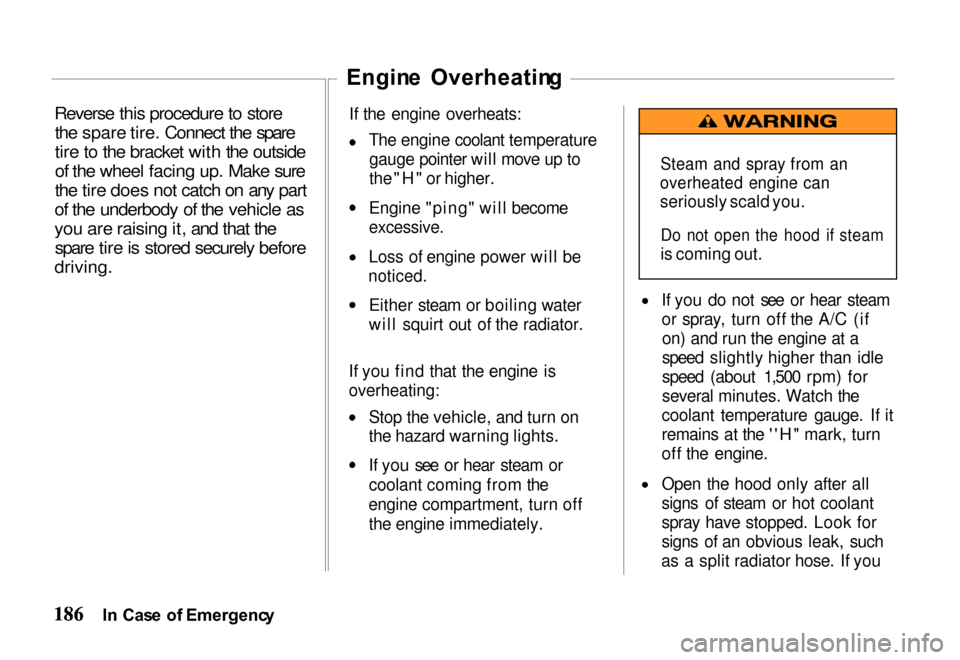
Reverse this procedure to store
the spare tire. Connect the spare
tire to the bracket with the outside
of the wheel facing up. Make sure
the tire does not catch on any part
of the underbody of the vehicle as
you are raising it, and that the spare tire is stored securely before
driving.
If the engine overheats:
The engine coolant temperaturegauge pointer will move up to
the "H" or higher. Engine "ping" will become
excessive.
Loss of engine power will be
noticed.
Either steam or boiling water
will squirt out of the radiator.
If you find that the engine is
overheating:
Stop the vehicle, and turn on
the hazard warning lights.
If you see or hear steam or
coolant coming from the
engine compartment, turn off the engine immediately. If you do not see or hear steam
or spray, turn off the A/C (if
on) and run the engine at a
speed slightly higher than idle
speed (about 1,500 rpm) for
several minutes. Watch the
coolant temperature gauge. If it
remains at the ''H" mark, turn
off the engine.
Open the hood only after all
signs of steam or hot coolant
spray have stopped. Look for
signs of an obvious leak, such
as a split radiator hose. If you
I n Cas e o f Emergenc y
Steam and spray from an
overheated engine can
seriously scald you.
Do not open the hood if steam
is coming out.
Engin
e Overheatin g
Page 208 of 267

Sit in the driver's seat and
perform these checks:
1. With the engine stopped, depress the brake pedal severaltimes; the travel distance and
effective pedal stroke should
remain unchanged.
2. Start the engine with the brake pedal fully depressed.
The brake pedal should go downa little as the engine starts.
3. Depress the brake pedal, stop the engine and hold the pedal
depressed for about 30
seconds; the brake pedal
should remain in position
without rising or going down.
4. Restart the engine and run it for about a minute, then turn it
off and depress the brake
pedal firmly several times; the
brake pedal travel should decrease each time the brake
pedal is depressed.
If the brakes do not operate
normally, have them checked and
corrected by your Honda dealer.
Exhaus t syste m — Be alert to any
changes in the sound of the exhaust system or any smell of fumes.
These are signs the system may be leaking or overheating. Have the
system checked and/or repaired at
once if these conditions exist. (Also see "Carbon Monoxide Hazard" in
the "Driver and Passenger Safety"
section and "Three-Way Catalytic
Converter" in the "Driving Tips"
section.)
Windshiel d wiper s an d
washer s — Check the operation
and condition of the wiper blades.
Check the flow and aim of the
washer spray.
Defroster
s — Check performance
by moving the controls to the
defrost setting and noting the amount of air directed against the
windshield.
Rea r vie w mirror s an d su n
visor s — Check that the friction
joints hold the mirrors and sun visors firmly in place.
Hor n — Blow the horn now and
then to be sure it works.
La p an d shoulde r belt s — Check
the belt system, including
webbing, buckles, latch plates,
retractors, guide loops and anchors for proper operation and
damage.
Sea t adjuster s — When adjusting
a seat, be sure the seat adjusters
latch securely by pushing the seat
forward and backward.
Car e an d Maintenanc e
Page 216 of 267

The engine cooling system is
designed to maintain the engine at
the proper operating temperatures.
The cooling system was filled at the factory with a quality engine
coolant. The engine cooling system is designed to use coolant (a
mixture of water and ethylene glycol antifreeze) rather than plain
water. The engine coolant solutionshould be used year-round. It has
many advantages such as: provides freezing protection as
lowas — 33°F( — 36°C)
provides boiling protection up
to262°F(128°C)
protects against rust and
corrosion in the cooling system maintains the proper engine
temperature for efficient
operation and emission control
allows proper operation of the
engine coolant temperature gaugeSee the Maintenance Schedule in
this section to find out when the
engine coolant must be replaced.
Checkin g th e Coolan t Leve l
Check the engine coolant level at the interval shown in the
Maintenance Schedule unless there
is evidence of leaking or
overheating. The engine coolant
level should be between the
maximum and the minimum level
marks on the radiator reserve tank.
Car e an d Maintenanc e
Recommende
d Lubrican t
Engin
e Coolin g Syste m